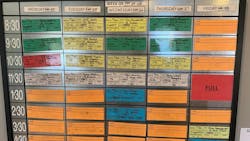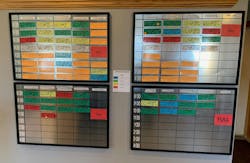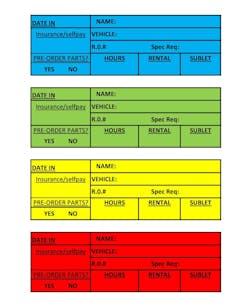Recently, I have had a few folks reach out for advice on how to better schedule incoming work. Even though the demand of incoming wrecked cars has slowed, “grabbing the keys” may get us the job, but it can wreak havoc on our system! Some also continue to bring cars in on Monday and Tuesday with hopes of delivery by the end of the week. In the end, the industry cycle time is 14-15 days, no matter what day the car is dropped off.
What is one to do or where is one to even start, you ask? Well, it all starts with the data. What is the current customer demand of how many cars are leaving, billed hours produced and dollars coming in per day? Using an example shop, we are going to find their current daily customer demand. ABC Auto Body’s management system reveals that in 2024 they made $3,000,000 in gross sales, fixed 500 cars, and billed 19,000 hours. If we divide their gross sales of $3,000,000 by 500 fixed cars, $6,000 is their average repair order. With 365 days in a year less 52 weekends and seven paid holidays, the average shop is open 254 days a year. So, 19,000 billed hours for 2024 / 254 Workings Days = 74.8 hours per day. So, this data tells us that ABC is producing around two cars or 75 hours, or around $12,000 per day. Some of the smaller shops are saying right now, “Greg, this is all great, but I don’t have a management system.” Well, I would just start with a simple Excel sheet and keep track of your outputs for these three metrics for two to three months. Then divide your totals by the working days tracked, as it’s quite simple math.
Even though ABC may be producing 10 cars per week, their inputs could be four cars in on Monday, three cars in on Tuesday, two cars in on Wednesday, and only one car in on Thursday, then nothing on Friday. ABC more than likely does not have the manpower to blueprint four cars on Monday, so two cars will sit until Tuesday. The two cars that were dropped off Tuesday will sit until Wednesday, and so on. And oh, what do we do with the two non-drives that were dropped off Monday? Sound familiar? It’s time to fix this.
In the world of Lean, the Japanese at Toyota use a term called: Heijunka = leveling or smoothing out. Heijunka is applicable to every department, such as Blueprint, Mirror Matching, Body, Prep, Paint, Build, Detail, and QC and Delivery. For this month’s column, we are just going to focus on using Heijunka for incoming scheduling.
Even though we are in the year 2025 and technology — including AI — is moving at lightning speed, a visual management system is still superior. Our brains, IF we allow them, can move faster than anything else. At my shop, we have a visual scheduling board on our office wall that is visible by the front-end employees and even by customers. Our incoming work is not stuck inside of some computer software or anything like that. We glance at the wall to see where we have capacity for the next car and where to put the next customer for a consultation/scheduling.
We just use 36” X 24” steel sheets trimmed in black painted wood and striped with vinyl tape. They blend in nicely with our gray office walls. Each sheet represents one week of our schedule. I simply went to Walmart and bought a 3M laminator and magnetic sticky sheets from their crafts department. We then made magnetic dry erase cards that are 5.5” X 2” in different colors. The cards have just a few bits of information for RO#, Name, Insurer, Rental?, Date In, Triage Hours, Special Requests, etc. When we look at car or see photos of a vehicle to schedule, we will triage the job by a color-coded job size category. Colors are Blue =0-9.9 hours, Green =10-19.9 hours, Yellow =20-39.9 hours and Red 40+ hours.
How do we know what colors to schedule each day? For the ABC example shop, they can’t schedule 75 hours per day. If they did this, not only would they have no capacity for non-drives, but sometimes a job triaged at 20 hours after Blueprint becomes 40. At my shop, I can’t schedule over 65% or so of my capacity. So, for ABC Auto Body, instead of scheduling 75 hours each day, they should schedule only 65% of 75 hours, or about 49 hours. This allows room for non-drives and triage surprises. Some of you are thinking, “What happens when a scheduled car after Blueprint is totaled by an insurance company?” That’s relatively easy; just reach out into the future and bring in a same-colored card to fill the opening. Reach out if you need help.





